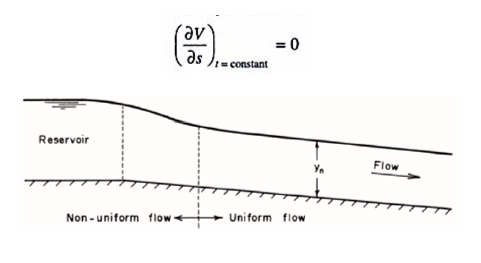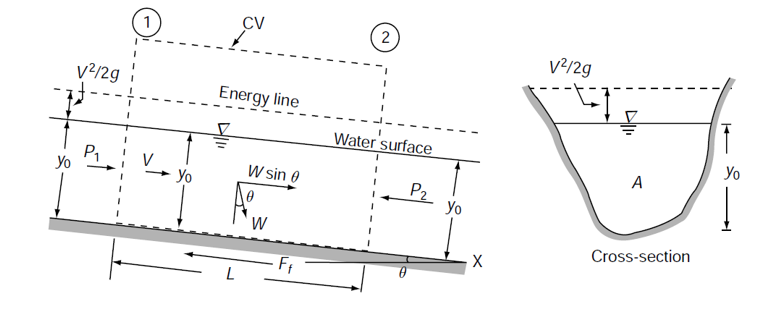Study characteristics of flow on a plane and gravel bed
Objectives:
- To derive Chezy’s and Manning’s roughness coefficients for S6 Tilting Flume in laboratory.
- To study the effect of Chezy’s and Manning’s roughness coefficient on plane and gravel bed.
- To study relationship between Chezy’s and Manning’s roughness coefficient.
- To compare average Chezy’s and Manning’s roughness coefficients with the values available in literature.
- To plot the bed profile, hydraulic grade line & energy line for different discharges on different beds.
Apparatus:
- S6 tilting flume
- Point gauge
- Plane and gravel bed arrangement
Related theory:
Flume:
Flume is a man-made open channel for flow of water in the form off open declined gravity channel.
Flow:
The quantity of fluid passing through any particular section per unit time.
Uniform flow:
A flow in which flow parameters like velocity, depth & pressure remains constant in between two sections of a pipe or channel at any given instant of time.


Figure: Uniform Flow
Non-uniform flow:
A flow in which flow parameters like velocity, depth & pressure do not remain constant in between two sections of a pipe or channel at any given instant of time.

Figure: Establishment of uniform flow in a long channel
Steady flow:
The type of flow in which the fluid characteristics like velocity, pressure, density etc at a point do not change with time

Unsteady flow:
The type of flow in which the fluid characteristics like velocity, pressure, density etc at a point change with time.

Laminar flow:
The type of flow in which the fluid particles move along well defined paths or stream line and all the stream lines are straight and parallel. This type of flow is also called stream line flow or viscous flow.
Its Reynold number is less than 2000.
Turbulent flow:
The flow in which the fluid particles move in a zig-zag way. Due to movement in this manner, the eddies formation takes place which are responsible for high energy loss.
Its Reynold number is more than 4000.
Note: if Rn lies between 2000-4000, the flow may be laminar or turbulent.
Open channel:
A conduit in which fluid flow is with a free surface and under gravity.
Prismatic channel:
Channels having same cross sections are prismatic.
Chezy’s formula:
The formula is named after Antoine de Chézy, the French hydraulics engineer who devised it in 1775. It describes the mean flow velocity of steady, turbulent open channel flow.
![]()
Where,
c= Chezy’s constant and it depends on roughness of the channel bed (m1/2s-1)
v= Average velocity (m/s)
R= Hydraulic radius (m)
S= Slope of energy line (m/m)
Manning’s formula:
It is an empirical formula estimating the average velocity of a liquid flowing in a conduit that does not completely enclose the liquid, i.e., open channel flow. However, this equation is also used for calculation of flow variables in case of flow in partially full conduits, as they also possess a free surface like that of open channel flow. All flow in so-called open channels is driven by gravity. It was first presented by the French engineer Philippe Gauckler in 1867, and later re-developed by the Irish engineer Robert Manning in 1890.

Where,
n= Manning’s coefficient (s/m1/3)
v= Average velocity (m/s)
R= Hydraulic radius (m)
S= Slope of energy line (m/m)
Factors affecting Manning’s roughness coefficient:
- Surface roughness (for fine grained less “n”, fine coarse grained more “n” value)
- Vegetation (height, density, distribution and type of vegetation)
- Channel irregularity (variation in wetted perimeter, shape, cross section & size along channel length)
- Channel alignment (smooth curvature with large radius will give less “n” value whereas sharp curvature with severe meandering will increase “n”
- Silting and scouring
- Obstruction
- Size and shape of channel
- Stage and discharge
- Seasonal change
- Suspended material and bed load
Importance of determining Manning’s roughness coefficient:
- It estimates the resistance to flow in a given channel or pipe.
- Different types of channels have different n values e.g. earthen channels, concrete channels. If these values are not correctly estimated then velocity and discharge would not be accurately determined.
- The value also changes with respect to bed grains of channel.
- For the design of power channels, the correct manning’s roughness coefficient is required.
- Also, in irrigation channels the manning’s roughness coefficient is required for proper channel design.
Relation between Chezy’s and Manning’s roughness coefficient:
C=R1/6/n
Procedure:
- Turn the pump on of the apparatus.
- Wait to stabilize the water in flume
- Measure the width of the channel (B).
- Adjust suitable value of the slope.
- For constant values of slope, vary discharge “Q” and measure depth of flow of water at different locations and take the average depth.
- Compute area of flow, wetted perimeter, velocity, hydraulic radius, Chezy’s and Manning’s roughness coefficient.
- Plot energy line and graphs between n & v, c &v, n &c of plane and gravel beds.
Observations and calculations:
Flume dimensions:
| Width | 300 mm |
| Length | 10 m |
| Slope | 1:500 |

Result:
Average Chezy’s constant for plain bed= 42.266 m1/2s-1
Average Manning’s constant for plain bed= 14.777 *10-3 s/m1/3




Result:
Average Chezy’s constant for plain bed= 65.381 m1/2s-1
Average Manning’s constant for plain bed= 9.213 *10-3 s/m1/3



Bed profile, hydraulic grade line and energy line for gravel bed










Comments:
- The manning’s and Chezy’s constants have not been calculated by using slope of energy lines because slope of energy lines are coming to be negative in graphs. The negative slope will give undefined results for the calculations of co-efficients.
- The reason of negative slope is that with increasing distance the depth of water is increasing which is not the real scenario. It should be decreasing.
- The graph of C vs V & n vs V are nearly straight line which shows that it is the property of bed which does not change with change in velocity.
- From the graph of manning’s vs chezy’s roughness coefficients it can be verified that these two are inversely proportional to each other.
- The literature values are reported in comparison table which indicates that our results are close to literature values.
